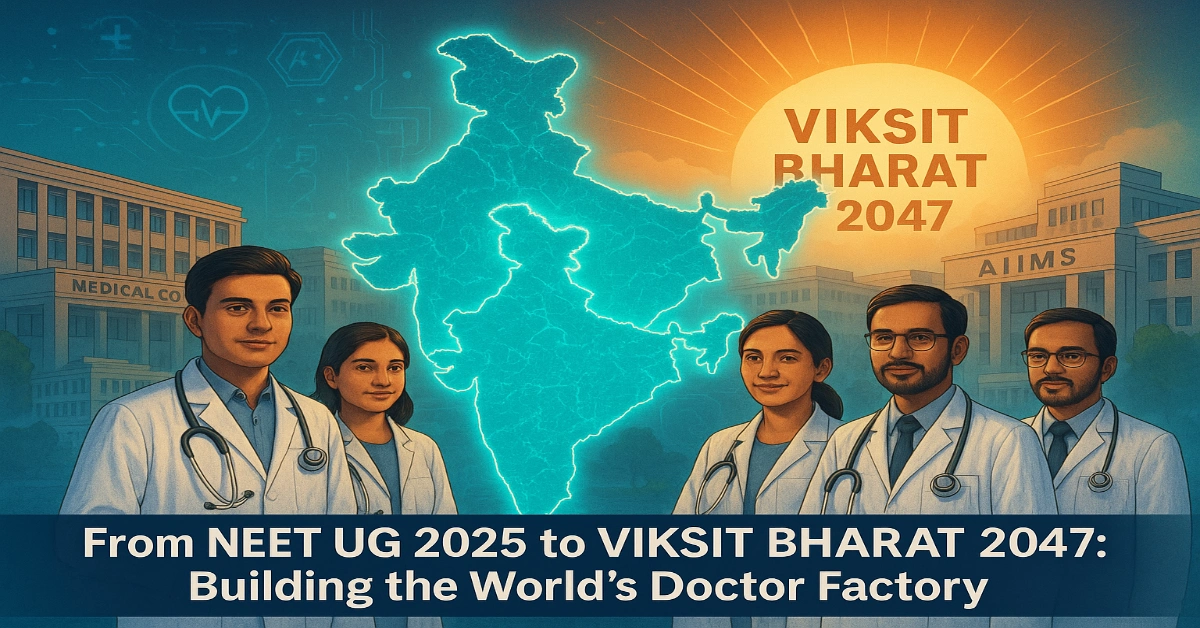NEET UG 2025 to Viksit Bharat 2047: On a humid evening in Begusarai, Bihar, 18-year-old Samiksha sat on her terrace revising biology notes. Her dream? To crack NEET UG 2026 and become the first doctor in her family. But unlike earlier generations of aspirants who faced the crushing reality of limited medical seats, Ananya’s future feels brighter.
By 2026, India will have over 1.36 lakh MBBS seats, thanks to the National Medical Commission (NMC) and the government’s commitment to add 75,000 new seats within five years. This is not just a number, it’s India’s medical education revolution in access, ambition, and national purpose.
As India marches toward its grand vision of “Viksit Bharat 2047,” the expansion of medical colleges & education stands at the heart of a new transformation, one that aims to make India the world’s largest medical education hub and the “doctor factory of the world.”
Viksit Bharat 2047: India’s Medical Education Revolution
In 2014, India had around 54,000 MBBS seats across government and private colleges. Fast forward to 2025, and that number has more than doubled. By 2030, the goal is to cross 2 lakh MBBS seats, a scale unmatched by any nation.
“Healthcare and education are the twin pillars of Viksit Bharat. Expanding medical education is not just about producing doctors, it’s about nation-building,” – Prime Minister Narendra Modi, 2024 Independence Day address
This expansion isn’t just an academic exercise, it’s a strategic national mission. India’s growing healthcare demand, coupled with its ambition to become a global talent hub, has made medical education a central theme in its development story.
| Viksit Bharat 2047 is the government’s vision to transform the country into a self-reliant and prosperous economy by 2047. Economic growth, technological upgradation, infrastructure development, social empowerment, and sustainability are the criteria of this programme. Steps towards achieving this were charted in the Union Budget 2025-26, as Finance Minister Nirmala Sitharaman announced a few priorities to create opportunities and drive progress in accordance with the overall strategy outlined in the interim budget. |
The Numbers That Tell a Story
| Year | Total MBBS Seats | Medical Colleges | Key Milestones |
|---|---|---|---|
| 2014 | 54,000 | 381 | Start of rapid expansion |
| 2020 | 80,000 | 562 | NMC replaces MCI |
| 2025 | 1,26,000+ | 812 | Record growth |
| 2026 (Projected) | 1,36,000+ | 840+ | NMC’s new approvals |
| 2030 (Target) | 2,00,000 | 1000 | India as world leader |
Behind these figures lies a powerful policy framework, one that connects education, employment, and healthcare access.
Read Also: NMC Diwali Bonanza: 812 Medical Colleges & 1,26,600 MBBS Seats for NEET Aspirants
Why This Expansion Matters: India’s Plan to Become the World’s Doctor Factory
For decades, India has faced a paradox: millions of aspiring doctors, but too few seats. With over 24 lakh students appearing for NEET UG 2025, the competition remains fierce, but hope is rising.
This seat expansion will:
- Democratise access for students from smaller towns and rural areas
- Reduce brain drain: fewer students forced to go abroad for MBBS
- Create local healthcare capacity by ensuring doctors are trained closer to underserved areas
- Boost rural health systems by staffing PHCs and CHCs with qualified professionals
As Dr. Vikrant Kapoor, a senior public health expert, notes:
“Expanding seats is not just about numbers; it’s about redistributing opportunity. Every new medical college in a Tier-3 district is a new chance for equity.”
Aligning with the National Vision: Viksit Bharat 2047 and Healthcare for All
The Viksit Bharat 2047 vision, India’s roadmap for becoming a developed nation by its 100th Independence anniversary, places healthcare and education at its core.
Medical education reform aligns with flagship programs such as:
- Ayushman Bharat Digital Mission (ABDM): Integrating digital healthcare records
- National Health Mission (NHM): Strengthening PHCs and CHCs
- PM-Ayushman Bharat Health Infrastructure Mission: Creating medical colleges in every district
- Skill India and PM Kaushal Vikas Yojana: Training allied health professionals
Together, these policies aim to ensure “Healthcare for All by 2047.”
Read Also: NMC Updated MBBS Seat Matrix 2025 Again
The New Architecture: AIIMS, NMC, and Private Partnerships
New AIIMS: The Backbone of Modern Medical Training
In 2014, India had 7 AIIMS. Today, there are 23 AIIMS, from Raebareli to Kalyani, each serving as a model for tertiary care, research, and advanced training.
These institutes represent India’s push for uniform medical excellence across regions.
NMC’s Role: Regulation for the Future
The National Medical Commission (NMC), established in 2020, replaced the outdated MCI system with transparent, tech-driven oversight.
Its Medical Assessment and Rating Board (MARB) now ensures that seat expansions maintain quality standards.
PPP Model and Private Sector Role
Private colleges contribute nearly 50% of all MBBS seats, and under the government’s Public-Private Partnership (PPP) model, new colleges are emerging near district hospitals to ensure both affordability and training access.
“The new PPP model will ensure that even private education serves a public purpose,” – NMC official, 2025
India’s Global Leap: From Brain Drain to Brain Gain
In the past decade, over 80,000 Indian students left for MBBS studies in countries like Georgia, Russia, and the other MBBS Abroad destinations. But the next decade could reverse this trend.
With India’s rapid seat expansion and improving academic standards, many foreign universities may soon seek collaboration with Indian institutions instead.
For example, the Grigol Robakidze University (GRUNI) of Georgia has already collaborated with Bhartiya Vidyapeeth Pune in academy and research.
Already, global medical regulators are recognizing India’s reforms.
WHO representatives have praised NMC’s efforts to align Indian medical education with Global Minimum Standards for Medical Training (GMSMT).
India’s goal is clear, to become a net exporter of medical talent.
By 2030, it aims to train enough doctors not just for domestic needs but also to serve the global healthcare workforce shortage.
Students at the Center: Stories of Aspiration and Opportunity
In Saharsa, 19-year-old Rishabh Raj, the son of a tailor, recently secured a seat in a new government medical college.
“My father always said, ‘Mai kapda silta hun lekin tu mareez (I stitch cloths but you’ll patients).’ The new college made that possible right here in my state,” he smiles.
In Delhi, Ritu, preparing for NEET 2026, says:
“Earlier, everyone said only the rich could afford MBBS. Now, more government seats mean people like us can dream too.”
These personal stories capture what numbers can’t, the social mobility medical education offers.
The Economic and Diplomatic Edge: Soft Power of Healthcare
India’s healthcare outreach already serves as a tool of diplomatic soft power, from sending vaccines under Vaccine Maitri to providing doctors during crises.
By becoming the world’s largest medical education hub, India can amplify that power:
- Medical tourism expected to reach $13 billion by 2026
- Foreign/NRI students enrolling in Indian MBBS programs rising steadily
- Academic collaborations with Africa, ASEAN, and Middle East nations
- AIIMS-like models being replicated abroad under India’s technical assistance
“The next export from India will not be just software or pharmaceuticals, it will be skilled doctors trained in Indian classrooms,” – Policy think-tank statement, NITI Aayog 2025
Digital Disruption and the Future of Medical Learning
The next leap in Indian medical education is digital.
Smart classrooms, AI-based anatomy tools, telemedicine labs, and integrated simulation centers are transforming the way medicine is taught.
NMC’s 2025 guidelines encourage colleges to:
- Adopt digital logbooks and competency-based curricula
- Integrate AI and data science into medical training
- Offer virtual reality-based clinical exposure
India’s EdTech firms are already collaborating with medical institutions to build hybrid learning modules, a step toward democratizing high-quality medical education even further.
Road to 2047: From Quantity to Quality
While expansion is vital, India’s next challenge will be ensuring academic quality, faculty development, and research innovation.
The government’s 2047 vision emphasizes:
- Faculty training programs through NMC’s National Faculty Development Programme Portal
- Research integration via ICMR-NMC partnerships
- Accreditation reforms to rank colleges on teaching, ethics, and innovation
The idea is simple: every new college must not just produce doctors, it must produce leaders in healthcare.
A Global Dream Rooted in Local Promise
By 2047, India envisions itself as a nation where every district has a medical college, every child has access to a doctor, and every young aspirant has a fair chance to heal and serve.
The journey from NEET UG 2025 to Viksit Bharat 2047 is not merely a policy timeline, it’s a national awakening.
It’s about turning dreams like Ananya’s and Arun’s into a collective force that defines a New Bharat, educated, healthy, and globally respected.
Read Also: NMC Fee Guidelines: 50% Private Medical Seats at Govt College Fees
The World’s Doctor Factory, Built in Bharat
From 54,000 seats in 2014 to a projected 2 lakh by 2030, India’s medical education story is one of vision, willpower, and reform.
Each seat represents not just a number but a life that will save lives. Each college stands as a symbol of a nation healing itself while preparing to heal the world.
As NEET UG 2025 candidates prepare for their exams, they’re not just competing for admissions, they’re becoming part of a global transformation led by Bharat.
By 2047, when India celebrates a century of independence, it will also celebrate something equally profound: “A nation that turned education into empowerment, medicine into mission, and doctors into ambassadors of a new global India.“

